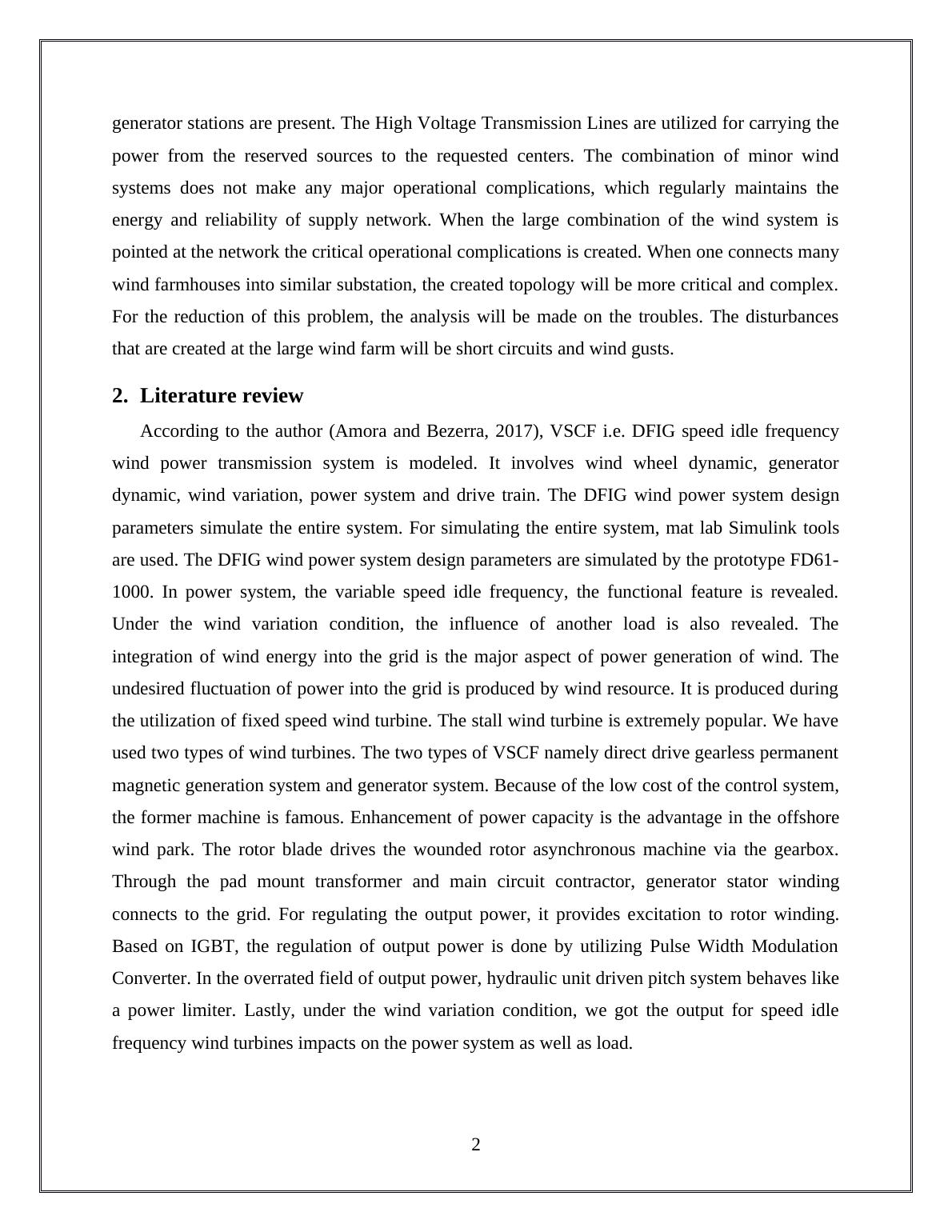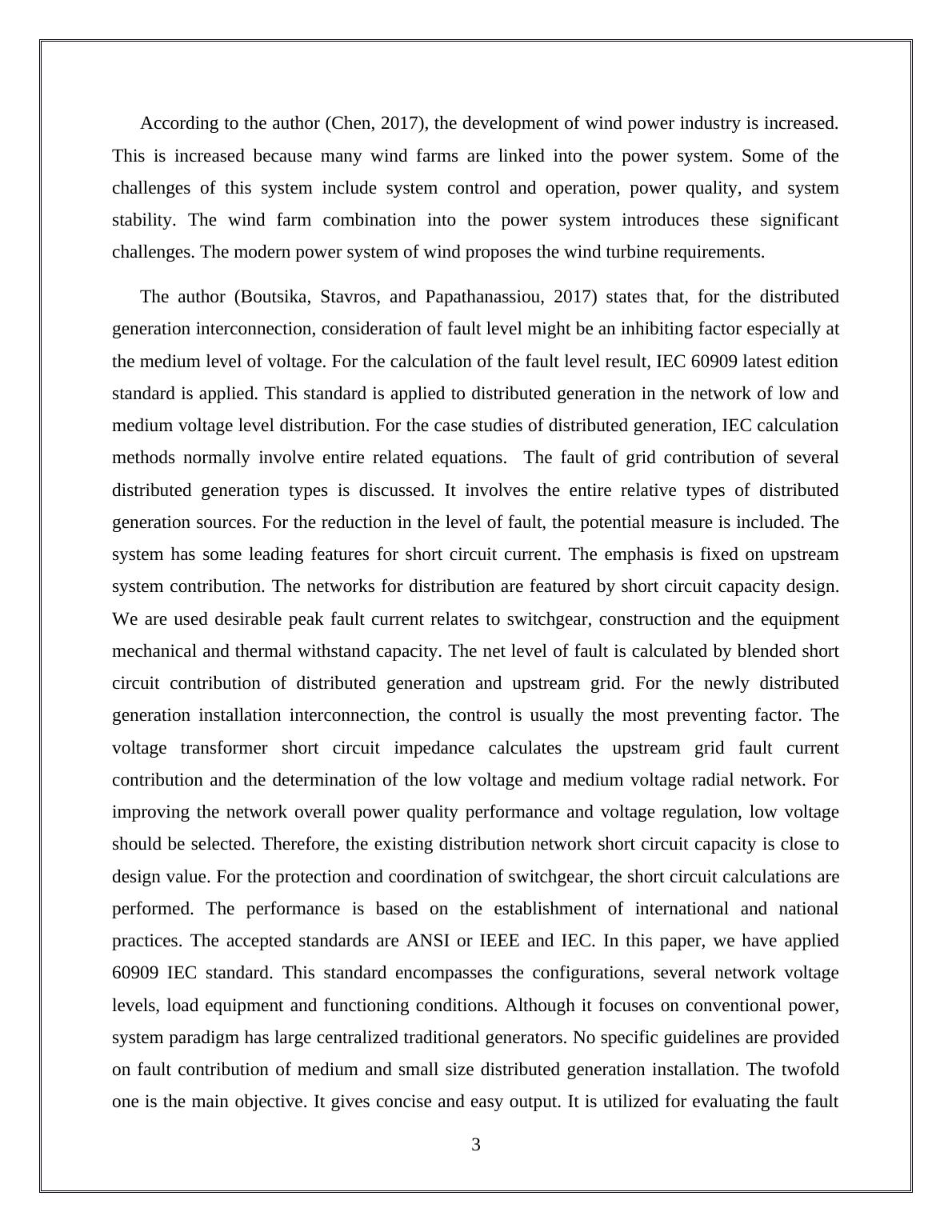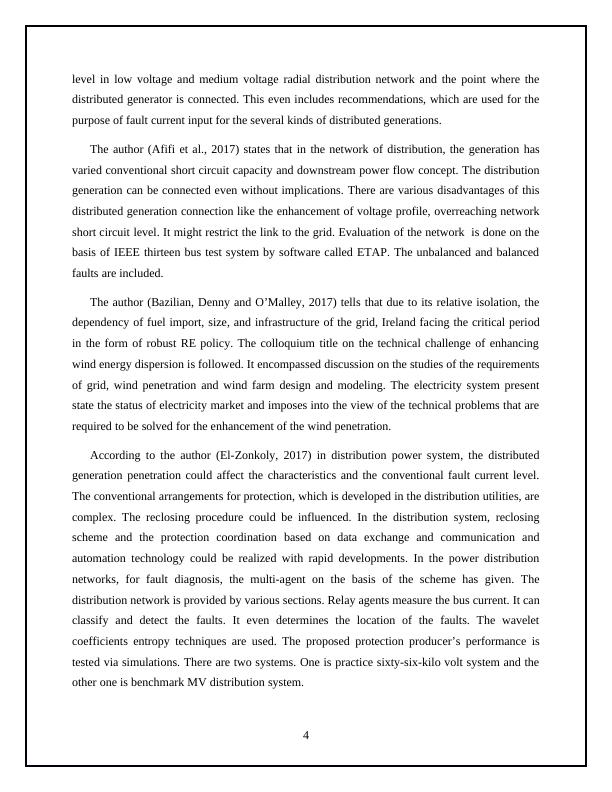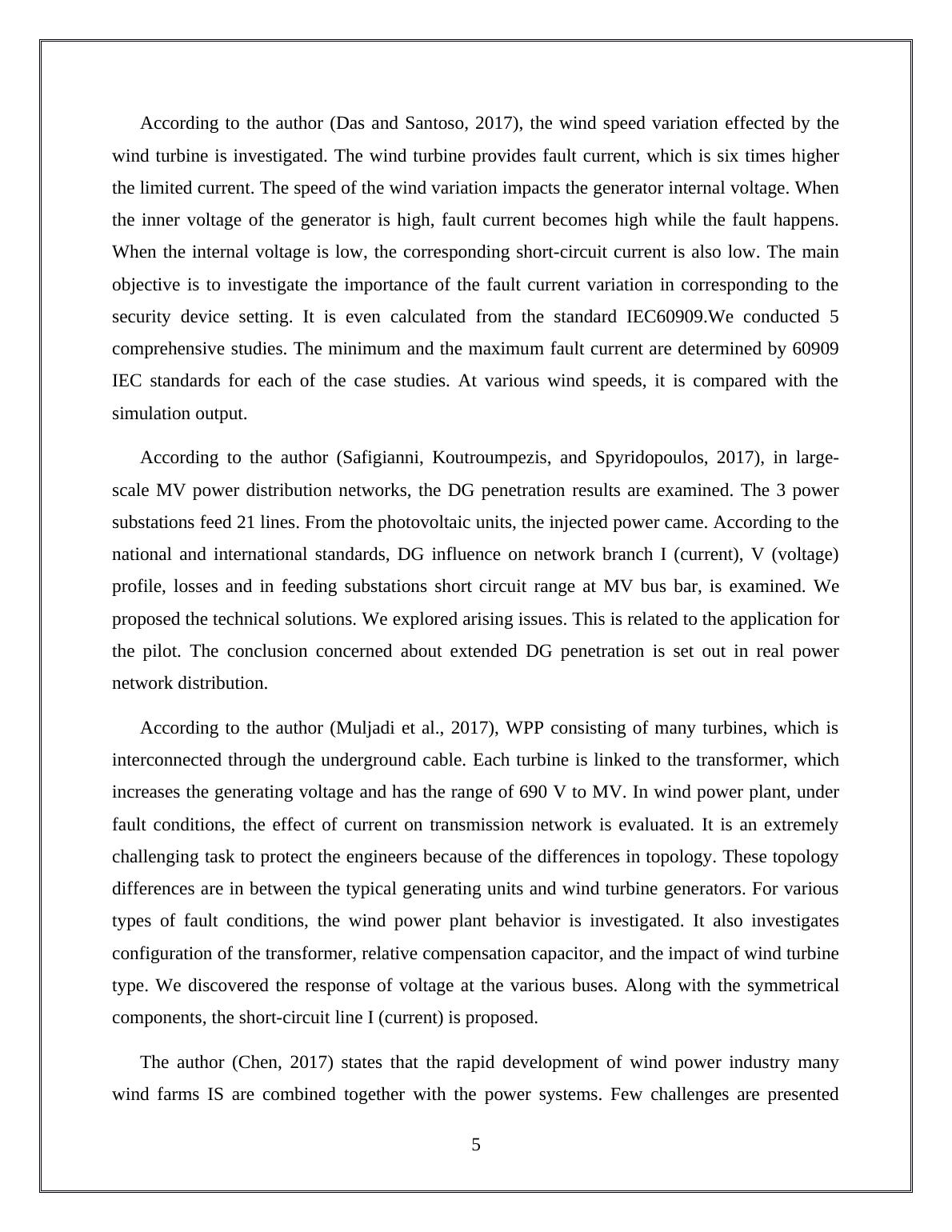Report on Short Circuit Calculations in Networks
Added on 2020-05-08
75 Pages13475 Words38 Views
Short circuit calculations in networks with large
penetration of distributed generation
0
penetration of distributed generation
0

Table of Contents
Table of Contents...........................................................................................................................1
1. Introduction.........................................................................................................................1
2. Literature review................................................................................................................2
3. Aim and Objective..............................................................................................................8
4. Methodology......................................................................................................................14
4.1 Grid Component Model...............................................................................................15
4.2 Modelling of Wind turbine..........................................................................................16
4.3 Variable Speed Wind Turbine.....................................................................................17
4.4 Variable speed DFIG wind turbine.............................................................................17
4.5 Variable speed wind turbine with synchronizer generator..........................................19
4.6 Variable speed DFIG wind turbines- fault analysis....................................................21
4.7 DFIG protection system during grid faults..................................................................24
4.8 Fixed speed wind turbine............................................................................................25
5. Expected Outcome............................................................................................................30
6. Work Plan..........................................................................................................................51
7. Conclusion.........................................................................................................................53
8. Bibliography......................................................................................................................55
1
Table of Contents...........................................................................................................................1
1. Introduction.........................................................................................................................1
2. Literature review................................................................................................................2
3. Aim and Objective..............................................................................................................8
4. Methodology......................................................................................................................14
4.1 Grid Component Model...............................................................................................15
4.2 Modelling of Wind turbine..........................................................................................16
4.3 Variable Speed Wind Turbine.....................................................................................17
4.4 Variable speed DFIG wind turbine.............................................................................17
4.5 Variable speed wind turbine with synchronizer generator..........................................19
4.6 Variable speed DFIG wind turbines- fault analysis....................................................21
4.7 DFIG protection system during grid faults..................................................................24
4.8 Fixed speed wind turbine............................................................................................25
5. Expected Outcome............................................................................................................30
6. Work Plan..........................................................................................................................51
7. Conclusion.........................................................................................................................53
8. Bibliography......................................................................................................................55
1

List of Figures
Figure 1 Horizontal axis wind turbine...........................................................................................12
Figure 2 Co-axial, multi-rotor horizontal axis...............................................................................13
Figure 3 Vertical axis wind turbine...............................................................................................14
Figure 4 Giromill wind turbine......................................................................................................15
Figure 5 Onshore...........................................................................................................................15
Figure 6 Offshore...........................................................................................................................16
Figure 7 Grid Component Model..................................................................................................18
Figure 8 Configuration..................................................................................................................25
Figure 9 Gain scheduling control..................................................................................................26
Figure 10 SVC control...................................................................................................................29
Figure 11 Gantt chart.....................................................................................................................51
2
Figure 1 Horizontal axis wind turbine...........................................................................................12
Figure 2 Co-axial, multi-rotor horizontal axis...............................................................................13
Figure 3 Vertical axis wind turbine...............................................................................................14
Figure 4 Giromill wind turbine......................................................................................................15
Figure 5 Onshore...........................................................................................................................15
Figure 6 Offshore...........................................................................................................................16
Figure 7 Grid Component Model..................................................................................................18
Figure 8 Configuration..................................................................................................................25
Figure 9 Gain scheduling control..................................................................................................26
Figure 10 SVC control...................................................................................................................29
Figure 11 Gantt chart.....................................................................................................................51
2

1. Introduction
The Electric power will be generated from the renewable energy, an example of which is
wind energy. The DigSilient software will simulate the power system. Electric Power Systems is
a complicated and complex structure. The electricity grid will be inserted into the whole
structure. At current situation, the requirement for the electric power is increased in the world.
For providing the power with low Carbon Emissions, this renewable energy is utilized. Electric
Power System comprises of many functions like the evaluation of the flow of load flow,
evaluation of the short path and fault, earthlings revisions, switchover voltages and insulation
organization. It is normally utilized for the production of the electrical energy. The power system
creates efficient and low-cost electricity. It has the components for the distribution and
transmission of electricity to the consumers. This power system has some of the major
components like transformers, power stations, alternators, circuit breakers, bus bars and auxiliary
devices. Nowadays, the power is generated by utilizing renewable energy like sunlight, wind,
tides, rain, waves and various type of biomass. This renewable energy helps in the reduction of
the carbon segregations, purification of the air, protection of the health of human from the
pollution and saving the functions of earth. Being inexhaustible in nature, the energy is produced
from the natural resources and is never depleted. It can also be used instead of fossil fuels and
thus can be termed as eco friendly in nature. Power generation is done by one of the important
renewable energy, wind. Apart from being eco friendly, wind energy is inexpensive and follows
a simple procedure for power generation. Moreover, this energy is also utilized for all types of
practical uses like charging batteries, pushing water and crushing grain. The kinetic energy from
the wind is utilized for the generation of mechanical power, which also provides benefits to both
economy and environment. Power analysis is performed by utilizing inexpensive software
known as Dig SILENT. The main functions of this software include handling of data, better
improved workflow and modeling capabilities. Moreover, it also helps in the reduction of the
execution cost of project and training requirement. The operating process of Dig SILENT is
extremely easy. It is also used in high-end applications like circulated generation, wind power
and handling process of large Power Systems. The electricity grid acts as a mediator network for
delivering electricity from producers to the consumers. For the production of electrical power
1
The Electric power will be generated from the renewable energy, an example of which is
wind energy. The DigSilient software will simulate the power system. Electric Power Systems is
a complicated and complex structure. The electricity grid will be inserted into the whole
structure. At current situation, the requirement for the electric power is increased in the world.
For providing the power with low Carbon Emissions, this renewable energy is utilized. Electric
Power System comprises of many functions like the evaluation of the flow of load flow,
evaluation of the short path and fault, earthlings revisions, switchover voltages and insulation
organization. It is normally utilized for the production of the electrical energy. The power system
creates efficient and low-cost electricity. It has the components for the distribution and
transmission of electricity to the consumers. This power system has some of the major
components like transformers, power stations, alternators, circuit breakers, bus bars and auxiliary
devices. Nowadays, the power is generated by utilizing renewable energy like sunlight, wind,
tides, rain, waves and various type of biomass. This renewable energy helps in the reduction of
the carbon segregations, purification of the air, protection of the health of human from the
pollution and saving the functions of earth. Being inexhaustible in nature, the energy is produced
from the natural resources and is never depleted. It can also be used instead of fossil fuels and
thus can be termed as eco friendly in nature. Power generation is done by one of the important
renewable energy, wind. Apart from being eco friendly, wind energy is inexpensive and follows
a simple procedure for power generation. Moreover, this energy is also utilized for all types of
practical uses like charging batteries, pushing water and crushing grain. The kinetic energy from
the wind is utilized for the generation of mechanical power, which also provides benefits to both
economy and environment. Power analysis is performed by utilizing inexpensive software
known as Dig SILENT. The main functions of this software include handling of data, better
improved workflow and modeling capabilities. Moreover, it also helps in the reduction of the
execution cost of project and training requirement. The operating process of Dig SILENT is
extremely easy. It is also used in high-end applications like circulated generation, wind power
and handling process of large Power Systems. The electricity grid acts as a mediator network for
delivering electricity from producers to the consumers. For the production of electrical power
1

generator stations are present. The High Voltage Transmission Lines are utilized for carrying the
power from the reserved sources to the requested centers. The combination of minor wind
systems does not make any major operational complications, which regularly maintains the
energy and reliability of supply network. When the large combination of the wind system is
pointed at the network the critical operational complications is created. When one connects many
wind farmhouses into similar substation, the created topology will be more critical and complex.
For the reduction of this problem, the analysis will be made on the troubles. The disturbances
that are created at the large wind farm will be short circuits and wind gusts.
2. Literature review
According to the author (Amora and Bezerra, 2017), VSCF i.e. DFIG speed idle frequency
wind power transmission system is modeled. It involves wind wheel dynamic, generator
dynamic, wind variation, power system and drive train. The DFIG wind power system design
parameters simulate the entire system. For simulating the entire system, mat lab Simulink tools
are used. The DFIG wind power system design parameters are simulated by the prototype FD61-
1000. In power system, the variable speed idle frequency, the functional feature is revealed.
Under the wind variation condition, the influence of another load is also revealed. The
integration of wind energy into the grid is the major aspect of power generation of wind. The
undesired fluctuation of power into the grid is produced by wind resource. It is produced during
the utilization of fixed speed wind turbine. The stall wind turbine is extremely popular. We have
used two types of wind turbines. The two types of VSCF namely direct drive gearless permanent
magnetic generation system and generator system. Because of the low cost of the control system,
the former machine is famous. Enhancement of power capacity is the advantage in the offshore
wind park. The rotor blade drives the wounded rotor asynchronous machine via the gearbox.
Through the pad mount transformer and main circuit contractor, generator stator winding
connects to the grid. For regulating the output power, it provides excitation to rotor winding.
Based on IGBT, the regulation of output power is done by utilizing Pulse Width Modulation
Converter. In the overrated field of output power, hydraulic unit driven pitch system behaves like
a power limiter. Lastly, under the wind variation condition, we got the output for speed idle
frequency wind turbines impacts on the power system as well as load.
2
power from the reserved sources to the requested centers. The combination of minor wind
systems does not make any major operational complications, which regularly maintains the
energy and reliability of supply network. When the large combination of the wind system is
pointed at the network the critical operational complications is created. When one connects many
wind farmhouses into similar substation, the created topology will be more critical and complex.
For the reduction of this problem, the analysis will be made on the troubles. The disturbances
that are created at the large wind farm will be short circuits and wind gusts.
2. Literature review
According to the author (Amora and Bezerra, 2017), VSCF i.e. DFIG speed idle frequency
wind power transmission system is modeled. It involves wind wheel dynamic, generator
dynamic, wind variation, power system and drive train. The DFIG wind power system design
parameters simulate the entire system. For simulating the entire system, mat lab Simulink tools
are used. The DFIG wind power system design parameters are simulated by the prototype FD61-
1000. In power system, the variable speed idle frequency, the functional feature is revealed.
Under the wind variation condition, the influence of another load is also revealed. The
integration of wind energy into the grid is the major aspect of power generation of wind. The
undesired fluctuation of power into the grid is produced by wind resource. It is produced during
the utilization of fixed speed wind turbine. The stall wind turbine is extremely popular. We have
used two types of wind turbines. The two types of VSCF namely direct drive gearless permanent
magnetic generation system and generator system. Because of the low cost of the control system,
the former machine is famous. Enhancement of power capacity is the advantage in the offshore
wind park. The rotor blade drives the wounded rotor asynchronous machine via the gearbox.
Through the pad mount transformer and main circuit contractor, generator stator winding
connects to the grid. For regulating the output power, it provides excitation to rotor winding.
Based on IGBT, the regulation of output power is done by utilizing Pulse Width Modulation
Converter. In the overrated field of output power, hydraulic unit driven pitch system behaves like
a power limiter. Lastly, under the wind variation condition, we got the output for speed idle
frequency wind turbines impacts on the power system as well as load.
2

According to the author (Chen, 2017), the development of wind power industry is increased.
This is increased because many wind farms are linked into the power system. Some of the
challenges of this system include system control and operation, power quality, and system
stability. The wind farm combination into the power system introduces these significant
challenges. The modern power system of wind proposes the wind turbine requirements.
The author (Boutsika, Stavros, and Papathanassiou, 2017) states that, for the distributed
generation interconnection, consideration of fault level might be an inhibiting factor especially at
the medium level of voltage. For the calculation of the fault level result, IEC 60909 latest edition
standard is applied. This standard is applied to distributed generation in the network of low and
medium voltage level distribution. For the case studies of distributed generation, IEC calculation
methods normally involve entire related equations. The fault of grid contribution of several
distributed generation types is discussed. It involves the entire relative types of distributed
generation sources. For the reduction in the level of fault, the potential measure is included. The
system has some leading features for short circuit current. The emphasis is fixed on upstream
system contribution. The networks for distribution are featured by short circuit capacity design.
We are used desirable peak fault current relates to switchgear, construction and the equipment
mechanical and thermal withstand capacity. The net level of fault is calculated by blended short
circuit contribution of distributed generation and upstream grid. For the newly distributed
generation installation interconnection, the control is usually the most preventing factor. The
voltage transformer short circuit impedance calculates the upstream grid fault current
contribution and the determination of the low voltage and medium voltage radial network. For
improving the network overall power quality performance and voltage regulation, low voltage
should be selected. Therefore, the existing distribution network short circuit capacity is close to
design value. For the protection and coordination of switchgear, the short circuit calculations are
performed. The performance is based on the establishment of international and national
practices. The accepted standards are ANSI or IEEE and IEC. In this paper, we have applied
60909 IEC standard. This standard encompasses the configurations, several network voltage
levels, load equipment and functioning conditions. Although it focuses on conventional power,
system paradigm has large centralized traditional generators. No specific guidelines are provided
on fault contribution of medium and small size distributed generation installation. The twofold
one is the main objective. It gives concise and easy output. It is utilized for evaluating the fault
3
This is increased because many wind farms are linked into the power system. Some of the
challenges of this system include system control and operation, power quality, and system
stability. The wind farm combination into the power system introduces these significant
challenges. The modern power system of wind proposes the wind turbine requirements.
The author (Boutsika, Stavros, and Papathanassiou, 2017) states that, for the distributed
generation interconnection, consideration of fault level might be an inhibiting factor especially at
the medium level of voltage. For the calculation of the fault level result, IEC 60909 latest edition
standard is applied. This standard is applied to distributed generation in the network of low and
medium voltage level distribution. For the case studies of distributed generation, IEC calculation
methods normally involve entire related equations. The fault of grid contribution of several
distributed generation types is discussed. It involves the entire relative types of distributed
generation sources. For the reduction in the level of fault, the potential measure is included. The
system has some leading features for short circuit current. The emphasis is fixed on upstream
system contribution. The networks for distribution are featured by short circuit capacity design.
We are used desirable peak fault current relates to switchgear, construction and the equipment
mechanical and thermal withstand capacity. The net level of fault is calculated by blended short
circuit contribution of distributed generation and upstream grid. For the newly distributed
generation installation interconnection, the control is usually the most preventing factor. The
voltage transformer short circuit impedance calculates the upstream grid fault current
contribution and the determination of the low voltage and medium voltage radial network. For
improving the network overall power quality performance and voltage regulation, low voltage
should be selected. Therefore, the existing distribution network short circuit capacity is close to
design value. For the protection and coordination of switchgear, the short circuit calculations are
performed. The performance is based on the establishment of international and national
practices. The accepted standards are ANSI or IEEE and IEC. In this paper, we have applied
60909 IEC standard. This standard encompasses the configurations, several network voltage
levels, load equipment and functioning conditions. Although it focuses on conventional power,
system paradigm has large centralized traditional generators. No specific guidelines are provided
on fault contribution of medium and small size distributed generation installation. The twofold
one is the main objective. It gives concise and easy output. It is utilized for evaluating the fault
3

level in low voltage and medium voltage radial distribution network and the point where the
distributed generator is connected. This even includes recommendations, which are used for the
purpose of fault current input for the several kinds of distributed generations.
The author (Afifi et al., 2017) states that in the network of distribution, the generation has
varied conventional short circuit capacity and downstream power flow concept. The distribution
generation can be connected even without implications. There are various disadvantages of this
distributed generation connection like the enhancement of voltage profile, overreaching network
short circuit level. It might restrict the link to the grid. Evaluation of the network is done on the
basis of IEEE thirteen bus test system by software called ETAP. The unbalanced and balanced
faults are included.
The author (Bazilian, Denny and O’Malley, 2017) tells that due to its relative isolation, the
dependency of fuel import, size, and infrastructure of the grid, Ireland facing the critical period
in the form of robust RE policy. The colloquium title on the technical challenge of enhancing
wind energy dispersion is followed. It encompassed discussion on the studies of the requirements
of grid, wind penetration and wind farm design and modeling. The electricity system present
state the status of electricity market and imposes into the view of the technical problems that are
required to be solved for the enhancement of the wind penetration.
According to the author (El-Zonkoly, 2017) in distribution power system, the distributed
generation penetration could affect the characteristics and the conventional fault current level.
The conventional arrangements for protection, which is developed in the distribution utilities, are
complex. The reclosing procedure could be influenced. In the distribution system, reclosing
scheme and the protection coordination based on data exchange and communication and
automation technology could be realized with rapid developments. In the power distribution
networks, for fault diagnosis, the multi-agent on the basis of the scheme has given. The
distribution network is provided by various sections. Relay agents measure the bus current. It can
classify and detect the faults. It even determines the location of the faults. The wavelet
coefficients entropy techniques are used. The proposed protection producer’s performance is
tested via simulations. There are two systems. One is practice sixty-six-kilo volt system and the
other one is benchmark MV distribution system.
4
distributed generator is connected. This even includes recommendations, which are used for the
purpose of fault current input for the several kinds of distributed generations.
The author (Afifi et al., 2017) states that in the network of distribution, the generation has
varied conventional short circuit capacity and downstream power flow concept. The distribution
generation can be connected even without implications. There are various disadvantages of this
distributed generation connection like the enhancement of voltage profile, overreaching network
short circuit level. It might restrict the link to the grid. Evaluation of the network is done on the
basis of IEEE thirteen bus test system by software called ETAP. The unbalanced and balanced
faults are included.
The author (Bazilian, Denny and O’Malley, 2017) tells that due to its relative isolation, the
dependency of fuel import, size, and infrastructure of the grid, Ireland facing the critical period
in the form of robust RE policy. The colloquium title on the technical challenge of enhancing
wind energy dispersion is followed. It encompassed discussion on the studies of the requirements
of grid, wind penetration and wind farm design and modeling. The electricity system present
state the status of electricity market and imposes into the view of the technical problems that are
required to be solved for the enhancement of the wind penetration.
According to the author (El-Zonkoly, 2017) in distribution power system, the distributed
generation penetration could affect the characteristics and the conventional fault current level.
The conventional arrangements for protection, which is developed in the distribution utilities, are
complex. The reclosing procedure could be influenced. In the distribution system, reclosing
scheme and the protection coordination based on data exchange and communication and
automation technology could be realized with rapid developments. In the power distribution
networks, for fault diagnosis, the multi-agent on the basis of the scheme has given. The
distribution network is provided by various sections. Relay agents measure the bus current. It can
classify and detect the faults. It even determines the location of the faults. The wavelet
coefficients entropy techniques are used. The proposed protection producer’s performance is
tested via simulations. There are two systems. One is practice sixty-six-kilo volt system and the
other one is benchmark MV distribution system.
4

According to the author (Das and Santoso, 2017), the wind speed variation effected by the
wind turbine is investigated. The wind turbine provides fault current, which is six times higher
the limited current. The speed of the wind variation impacts the generator internal voltage. When
the inner voltage of the generator is high, fault current becomes high while the fault happens.
When the internal voltage is low, the corresponding short-circuit current is also low. The main
objective is to investigate the importance of the fault current variation in corresponding to the
security device setting. It is even calculated from the standard IEC60909.We conducted 5
comprehensive studies. The minimum and the maximum fault current are determined by 60909
IEC standards for each of the case studies. At various wind speeds, it is compared with the
simulation output.
According to the author (Safigianni, Koutroumpezis, and Spyridopoulos, 2017), in large-
scale MV power distribution networks, the DG penetration results are examined. The 3 power
substations feed 21 lines. From the photovoltaic units, the injected power came. According to the
national and international standards, DG influence on network branch I (current), V (voltage)
profile, losses and in feeding substations short circuit range at MV bus bar, is examined. We
proposed the technical solutions. We explored arising issues. This is related to the application for
the pilot. The conclusion concerned about extended DG penetration is set out in real power
network distribution.
According to the author (Muljadi et al., 2017), WPP consisting of many turbines, which is
interconnected through the underground cable. Each turbine is linked to the transformer, which
increases the generating voltage and has the range of 690 V to MV. In wind power plant, under
fault conditions, the effect of current on transmission network is evaluated. It is an extremely
challenging task to protect the engineers because of the differences in topology. These topology
differences are in between the typical generating units and wind turbine generators. For various
types of fault conditions, the wind power plant behavior is investigated. It also investigates
configuration of the transformer, relative compensation capacitor, and the impact of wind turbine
type. We discovered the response of voltage at the various buses. Along with the symmetrical
components, the short-circuit line I (current) is proposed.
The author (Chen, 2017) states that the rapid development of wind power industry many
wind farms IS are combined together with the power systems. Few challenges are presented
5
wind turbine is investigated. The wind turbine provides fault current, which is six times higher
the limited current. The speed of the wind variation impacts the generator internal voltage. When
the inner voltage of the generator is high, fault current becomes high while the fault happens.
When the internal voltage is low, the corresponding short-circuit current is also low. The main
objective is to investigate the importance of the fault current variation in corresponding to the
security device setting. It is even calculated from the standard IEC60909.We conducted 5
comprehensive studies. The minimum and the maximum fault current are determined by 60909
IEC standards for each of the case studies. At various wind speeds, it is compared with the
simulation output.
According to the author (Safigianni, Koutroumpezis, and Spyridopoulos, 2017), in large-
scale MV power distribution networks, the DG penetration results are examined. The 3 power
substations feed 21 lines. From the photovoltaic units, the injected power came. According to the
national and international standards, DG influence on network branch I (current), V (voltage)
profile, losses and in feeding substations short circuit range at MV bus bar, is examined. We
proposed the technical solutions. We explored arising issues. This is related to the application for
the pilot. The conclusion concerned about extended DG penetration is set out in real power
network distribution.
According to the author (Muljadi et al., 2017), WPP consisting of many turbines, which is
interconnected through the underground cable. Each turbine is linked to the transformer, which
increases the generating voltage and has the range of 690 V to MV. In wind power plant, under
fault conditions, the effect of current on transmission network is evaluated. It is an extremely
challenging task to protect the engineers because of the differences in topology. These topology
differences are in between the typical generating units and wind turbine generators. For various
types of fault conditions, the wind power plant behavior is investigated. It also investigates
configuration of the transformer, relative compensation capacitor, and the impact of wind turbine
type. We discovered the response of voltage at the various buses. Along with the symmetrical
components, the short-circuit line I (current) is proposed.
The author (Chen, 2017) states that the rapid development of wind power industry many
wind farms IS are combined together with the power systems. Few challenges are presented
5

End of preview
Want to access all the pages? Upload your documents or become a member.
Related Documents
Advanced Power Quality: Wind Turbines and DFIGlg...
|39
|7105
|57
assignment | ELECTRICAL GENERATOR FOR WIND ENERGY BY USING HORIZONTAL WIND TURBINElg...
|48
|9062
|32
Assignment Project Information- Power System Investigationlg...
|9
|1642
|74
Advance Electrical Machines and Driveslg...
|39
|6447
|5
Wind Turbines Induction Generators (Doc)lg...
|14
|2434
|679
8. 1. ANALYSIS AND COMPARISON OF A CUSTOM CONSTRUCTED Slg...
|24
|6783
|259
